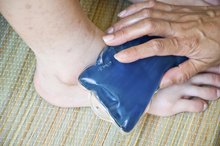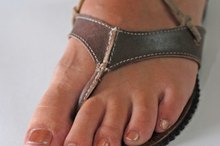Symptoms of a Torn Achilles Tendon
Your Achilles tendon is tough fibrous tissue that connects the heel to the muscles in your calf or back lower part of your leg. The Achilles is the thickest and strongest tendon in the body. When your calf muscles contract and pull on the Achilles tendon you push the foot downward. This motion allows you to stand on your toes, walk, run, and jump. Injuries to this tendon can be the result of overuse, misalignment when walking or running, improper footwear, weak or tight calf muscles and accidents. In severe cases the Achilles tendon can become torn. Learning to recognize the symptoms of a torn Achilles tendon will help you to get treatment as soon as possible to minimize complications.
Identification
The Achilles tendon can become strained, inflamed or tear. If a small tear goes untreated the tendon can actually rupture as seen here. Tears can be the result of tendinitis that goes on for a long period untreated. This condition will weaken the tendon and the fibers will be prone to tears. Tears can also happen when your tendon is subjected to an unexpected force or movement that places excessive strain on the tendon.
Initial Symptoms
How Long Does it Take to Rehabilitate a Snapped Achilles Tendon?
Learn More
Patients who experience a tear to the Achilles tendon often report hearing a popping or clicking sound at the time the tear occurs. It often feels as though you have been hit in the back of the leg. A partial tear may cause mild or no symptoms at all. Even with more significant tears there may be no pain or symptoms present at the time the injury occurs. The symptoms listed below can happen right when the tendon is torn or they may begin to occur later on.
Common Symptoms
According to the Institute for Foot and Ankle Reconstruction at Mercy Hospital, when you have a torn Achilles tendon, you may experience a sharp and stabbing pain around the Achilles. This may show up later in the day or it may not occur until a day or two later. The pain may subside after a period of rest but then return upon resuming your activity. You may also experience stiffness in the Achilles tendon upon waking and you may notice some slight swelling around the tendon. With time your leg will become weaker and you will have difficulty walking and moving your foot.
Complications
Torn Tendons & Ligaments From Hyperextension
Learn More
In severe cases there may be significant swelling and bruising. You may be unable to walk or move your foot at all. If self-care techniques such as rest, ice, compression and elevation do not resolve the problem, you may need medical intervention. Medications or injections to control the pain and inflammation may be prescribed. In some cases surgery to reattach the ends of the tendon may be necessary.
Prevention/Solution
Prevention is the key to avoiding a tear or rupture of the Achilles tendon. Avoid doing the same type of movement over and over, especially if it requires quick starting and stopping motions. Make sure you vary your workout routine by doing different activities. Build up slowly and avoid training too fast and too hard. Make sure you stretch properly and warm your body up before more vigorous activity. Wear good shoes that are especially designed for your activity. If you do participate in activities that stress this tendon, make sure you balance that with a strength training program for your leg muscles to help avoid excessive stress on the tendon.
Related Articles
Writer Bio
I hold a Master's degree in exercise physiology/health promotion. I am a certified fitness specialist through the American College of Spots Medicine and an IYT certified yoga teacher. I have over 25 years experience teaching classes to both general public and those with chronic illness. The above allows me to write directly to the reader based on personal experiences.









